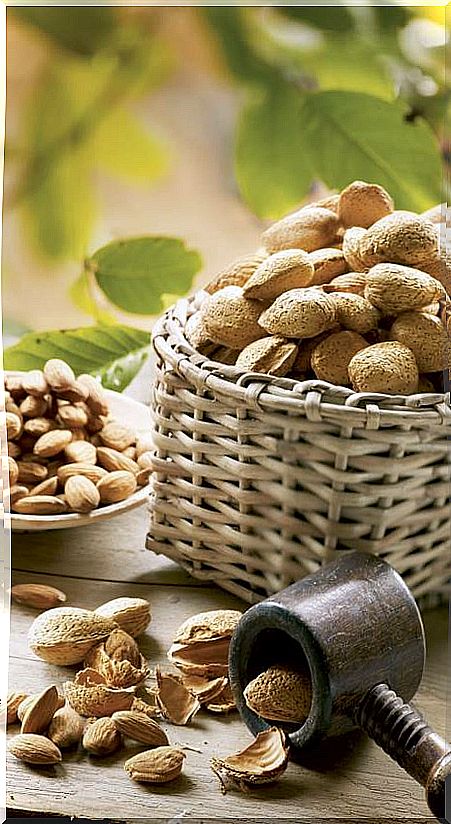Vegetables With A Lot Of Calcium: Better Than A Glass Of Milk
Nuts, seeds and green leaves are plant foods rich in calcium that are easy to assimilate. Make sure you get the one you need to protect your bones, nervous system, and heart.

Usually, when we talk about calcium, only “strong bones” come to mind, but the truth is that this mineral, in addition to being part of bones and teeth, fulfills many other functions in our body.
In our environment, the main dietary source of calcium is dairy, but that does not mean that they are essential. Nor should we fall into the common mistake of thinking that calcium intake is the only factor we must take into account to ensure good bone health.
Societies that traditionally do not consume dairy, such as the Japanese, do not seem to have more bone problems, on the contrary. Nor is it customary in China to take them, nor in a large part of the Asian and African population. Interestingly, they often exhibit better bone health and lower rates of osteoporosis than the “hyperlacteal” Western society.
Calcium is a mineral shrouded in many myths and ignorance. We answer some of the most common questions that may arise in this regard.
1. Why is calcium important for health?
Calcium not only plays a key role in our bones, it is also present in the blood, as it plays an important role in clotting.
It also works as an electrolyte: both in the brain, where it participates in sending and receiving nerve signals between neurons, and in muscles, where it is essential for their contraction and relaxation.
In addition, calcium is necessary for proper heart function and for the secretion of some hormones.
2. What are the symptoms of a calcium deficiency?
Not only can a calcium deficiency increase the risk of osteoporosis due to loss of bone mass, but it is also related to the appearance of muscle spasms, cramps, numbness and, in severe cases, palpitations and disorientation.
3. How much calcium do we have to take?
The recommendation of the EFSA, European food authority, is 1,000 mg a day between 18 and 24 years, and 950 mg a day from the age of 25, without changes in pregnancy or lactation. In Spain, in turn, the FESNAD advises 900 mg to adults, 1,000 mg to men over 60 and women over 50, and 1,200 mg to pregnant women.
4. Do vegetarians lack calcium?
According to the EPIC-Oxford Study (2007), lacto-ovo vegetarians have the same risk of fracture as the general population, although this is somewhat higher in vegans. But according to later studies (Ho-Pham et al., 2009) the difference is negligible. A 2012 study concludes that veganism does not affect bone loss.
5. What is the difference between content and bioavailability?
Do not confuse a food rich in calcium with one that is a good source because it has calcium that is easy to absorb. An example of the former is spinach, rich in calcium but with an absorption of less than 5%; of the second, cauliflower, with less calcium, but a bioavailability of almost 69%.
6. Are there plant foods rich in calcium?
It is found in the entire cruciferous family (broccoli, cauliflower, cabbage, kale, watercress, radishes …), in nuts such as almonds, seeds such as sesame, legumes (especially soybeans and beans), tofu (especially the curdled with calcium salts) and other soy derivatives. Here you have my selection of plant foods rich in calcium.
7. Can the bioavailability of calcium from plant foods be improved?
Yes, the phytates and oxalates contained in many plant foods reduce the absorption of calcium. Simple processes such as long cooking, soaking, fermentation, sprouting or roasting, in the case of nuts, help to improve it.
8. So does a vegetarian person have sufficient sources of calcium?
Yes. A plant-based diet rich in legumes, fruits, nuts, seeds, green leaves (except spinach), soybeans and derivatives and cruciferous, does not have to suffer a deficit. Calcium-fortified plant drinks may also be helpful.
9. Is it true that a diet rich in protein affects the absorption of calcium?
It is false that a diet rich in protein decalcifies. In fact, a correct protein intake is essential for good bone health. You have to take care of this aspect by consuming legumes, nuts or soy derivatives daily, among other sources of protein.
10. What other factors must be taken into account apart from diet?
A diet rich in calcium, vegetable or not, is useless if we do not expose ourselves to the sun to synthesize vitamin D, we exercise, we take little salt, we have a correct protein intake and we ensure magnesium and vitamin K.
11. Is it effective to take calcium in supplement or in high amounts?
No, it is not. This is pointed out by two 2015 investigations published in the British Medical Journal that conclude that increasing calcium intake above the recommended dose will not reduce our risk of suffering a fracture. You can see the conclusions of those investigations here and here.
12. What can I do if I already have osteoporosis?
The most effective interventions do not go so much through a high calcium intake as through strength training (better with professional supervision) and with sun exposure or vitamin D supplementation.









